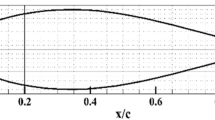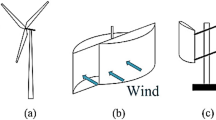Abstract
An asymmetric blade vertical-axis wind turbine (VAWT) is one of the emerging technologies for harvesting power in the built environment, which has low wind speed. Although asymmetric blade improves VAWT’s performance, the effect of blade pitch angle on its design is hardly ascertained. In this paper, unsteady 2D Reynolds-averaged Navier–Stokes CFD simulations are carried out to investigate the effect of blade pitch angle on the aerodynamic performance of a NACA 63-415 asymmetric blade H-Darrieus VAWT at a low wind speed of 6.0 m/s. Its detailed flow physics at different operating and pitch angle conditions is investigated, and important performance insights are obtained to elucidate its desired blade pitch for performance improvement. The present study shows that positive pitch angle (+ 5°) improves the turbine performance in upwind position, whereas negative pitch angle (− 5°) augments the turbine performance in downwind position as well as causes less wake effect than positive pitch angle. Further, optimal pitch angle (+ 5°) is found out at which the maximum power coefficient of 0.271 is obtained for an operating tip speed ratio 2.4. The present study delineates how desired blade pitch improves the performance of asymmetric blade VAWT for sustainable power generation in the built environment.

















Similar content being viewed by others
References
Zamani M, Maghrebi MJ, Moshizi SA (2016) Numerical study of airfoil thickness effects on the performance of J-shaped straight blade vertical axis wind turbine. Wind Struct Int J 22:595–616. https://doi.org/10.12989/was.2016.22.5.595
Castelli M, Betta DS, Bernini E (2012) Effect of blade number on a straight-bladed vertical axis wind turbine. World Acad Sci Eng Technol 61:305–311
Bedon G, Castelli M, Benini E (2012) Evaluation of the effect of rotor solidity on the performance of a H-Darrieus turbine adopting a blade element-momentum algorithm. World Acad Sci Eng Technol 6:1989–1994
Fiedler AJ, Tullis S (2009) Blade offset and pitch effects on a high solidity vertical axis wind turbine. Wind Eng 33:237–246. https://doi.org/10.1260/030952409789140955
Parra-Santos MT, Uzarraga CN, Gallegos A, Castro F (2015) Influence of solidity on vertical axis wind turbines. Int J Appl Math Electron Comput 3:215. https://doi.org/10.18100/ijamec.42848
Sun X, Wang Y, An Q et al (2014) Aerodynamic performance and characteristic of vortex structures for Darrieus wind turbine. II. The relationship between vortex structure and aerodynamic performance Aerodynamic performance and characteristic of vortex structures for Darrieus wind turbine. J Renew Sustain 043135:1–18. https://doi.org/10.1063/1.4893776
Li Q, Maeda T, Kamada Y et al (2015) Effect of number of blades on aerodynamic forces on a straight-bladed vertical axis wind turbine. Energy 90:784–795. https://doi.org/10.1016/j.energy.2015.07.115
Sun X, Wang Y, An Q et al (2014) Aerodynamic performance and characteristic of vortex structures for Darrieus wind turbine. I. Numerical method and aerodynamic performance. J Renew Sustain Energy. https://doi.org/10.1063/1.4893775
Roh SC, Kang SH (2013) Effects of a blade profile, the Reynolds number, and the solidity on the performance of a straight bladed vertical axis wind turbine. J Mech Sci Technol 27:3299–3307. https://doi.org/10.1007/s12206-013-0852-x
Lam HF, Liu YM, Peng HY et al (2018) Assessment of solidity effect on the power performance of H-rotor vertical axis wind turbines in turbulent flows. J Renew Sustain Energy. https://doi.org/10.1063/1.5023120
Sagharichi A, Zamani M, Ghasemi A (2018) Effect of solidity on the performance of variable-pitch vertical axis wind turbine. Energy. https://doi.org/10.1016/j.energy.2018.07.160
Joo S, Choi H, Lee J (2015) Aerodynamic characteristics of two-bladed H-Darrieus at various solidities and rotating speeds. Energy 90:439–451. https://doi.org/10.1016/j.energy.2015.07.051
Howell R, Qin N, Edwards J, Durrani N (2010) Wind tunnel and numerical study of a small vertical axis wind turbine. Renew Energy 35:412–422. https://doi.org/10.1016/j.renene.2009.07.025
Mohamed MH, Ali AM, Hafiz AA (2015) CFD analysis for H-rotor Darrieus turbine as a low speed wind energy converter. Eng Sci Technol Int J 18:1–13. https://doi.org/10.1016/j.jestch.2014.08.002
Ouro P, Stoesser T, Ramirez L (2018) Effect of blade cambering on dynamic stall in view of designing vertical axis turbines. J Fluids Eng 140:1–12. https://doi.org/10.1115/1.4039235
Mazarbhuiya HMSM, Biswas A, Sharma KK (2018) Performance prediction of asymmetrical bladed H-Darrieus VAWT rotors in low wind speed condition using CFD. pp 020040: https://doi.org/10.1063/1.5032002
Bausas MD, Danao LAM (2015) The aerodynamics of a camber-bladed vertical axis wind turbine in unsteady wind. Energy 93:1155–1164. https://doi.org/10.1016/j.energy.2015.09.120
Danao LA, Qin N, Howell R (2012) A numerical study of blade thickness and camber effects on vertical axis wind turbines. Proc Inst Mech Eng Part A J Power Energy 226:867–881. https://doi.org/10.1177/0957650912454403
Subramanian A, Yogesh SA, Sivanandan H et al (2017) Effect of airfoil and solidity on performance of small scale vertical axis wind turbine using three dimensional CFD model. Energy 133:179–190. https://doi.org/10.1016/j.energy.2017.05.118
Asr MT, Nezhad EZ, Mustapha F, Wiriadidjaja S (2016) Study on start-up characteristics of H-Darrieus vertical axis wind turbines comprising NACA 4-digit series blade airfoils. Energy 112:528–537. https://doi.org/10.1016/j.energy.2016.06.059
Jain P, Abhishek A (2016) Performance prediction and fundamental understanding of small scale vertical axis wind turbine with variable amplitude blade pitching. Renew Energy 97:97–113. https://doi.org/10.1016/j.renene.2016.05.056
Hwang IS, Lee YH, Kim SJ (2009) Optimization of cycloidal water turbine and the performance improvement by individual blade control. Appl Energy 86:1532–1540. https://doi.org/10.1016/j.apenergy.2008.11.009
Zeiner-Gundersen DH (2015) A novel flexible foil vertical axis turbine for river, ocean, and tidal applications. Appl Energy 151:60–66. https://doi.org/10.1016/j.apenergy.2015.04.005
Lazauskas L, Kirke BK (2012) Modeling passive variable pitch cross flow hydrokinetic turbines to maximize performance and smooth operation. Renew Energy 45:41–50. https://doi.org/10.1016/j.renene.2012.02.005
Li Q, Maeda T, Kamada Y et al (2016) Study on power performance for straight-bladed vertical axis wind turbine by field and wind tunnel test. Renew Energy 90:291–300
Islam M, Fartaj A, Carriveau R (2008) Analysis of the design parameters related to a fixed-pitch straight-bladed vertical axis wind turbine. Wind Eng 32:491–507. https://doi.org/10.1260/030952408786411903
Gosselin R, Dumas G, Boudreau M (2016) Parametric study of H-Darrieus vertical-axis turbines using CFD simulations. J Renew Sustain Energy. https://doi.org/10.1063/1.4963240
Sagharichi A, Maghrebi MJ, Arabgolarcheh A (2016) Variable pitch blades: an approach for improving performance of Darrieus wind turbine. J Renew Sustain Energy. https://doi.org/10.1063/1.4964310
Lee YT, Lim HC (2015) Numerical study of the aerodynamic performance of a 500 W Darrieus-type vertical-axis wind turbine. Renew Energy 83:407–415. https://doi.org/10.1016/j.renene.2015.04.043
Rezaeiha A, Kalkman I, Blocken B (2017) Effect of pitch angle on power performance and aerodynamics of a vertical axis wind turbine. Appl Energy 197:132–150. https://doi.org/10.1016/j.apenergy.2017.03.128
Li Q, Maeda T, Kamada Y et al (2017) Effect of rotor aspect ratio and solidity on a straight-bladed vertical axis wind turbine in three-dimensional analysis by the panel method. Energy 121:1–9. https://doi.org/10.1016/j.energy.2016.12.112
Chen CC, Kuo CH (2013) Effects of pitch angle and blade camber on flow characteristics and performance of small-size Darrieus VAWT. J Vis 16:65–74. https://doi.org/10.1007/s12650-012-0146-x
Eboibi O, Danao LAM, Howell RJ (2016) Experimental investigation of the influence of solidity on the performance and flow field aerodynamics of vertical axis wind turbines at low Reynolds numbers. Renew Energy 92:474–483. https://doi.org/10.1016/j.renene.2016.02.028
Armstrong S, Fiedler A, Tullis S (2012) Flow separation on a high Reynolds number, high solidity vertical axis wind turbine with straight and canted blades and canted blades with fences. Renew Energy 41:13–22. https://doi.org/10.1016/j.renene.2011.09.002
Abdalrahman G, Melek W, Lien FS (2017) Pitch angle control for a small-scale Darrieus vertical axis wind turbine with straight blades (H-Type VAWT). Renew Energy 114:1353–1362. https://doi.org/10.1016/j.renene.2017.07.068
Kjellin J, Bülow F, Eriksson S et al (2011) Power coefficient measurement on a 12 kW straight bladed vertical axis wind turbine. Renew Energy 36:3050–3053. https://doi.org/10.1016/j.renene.2011.03.031
Bhuyan S, Biswas A (2014) Investigations on self-starting and performance characteristics of simple H and hybrid H-Savonius vertical axis wind rotors. Energy Convers Manag 87:859–867. https://doi.org/10.1016/j.enconman.2014.07.056
Mohamed MH (2012) Performance investigation of H-rotor Darrieus turbine with new airfoil shapes. Energy 47:522–530. https://doi.org/10.1016/j.energy.2012.08.044
Beri H, Yao Y (2011) Effect of Camber Airfoil on Self-Starting of VAWT.pdf. J Environ Sci Technol 4:302–312
Archer CL, Jacobson MZ (2005) Evaluation of global wind power. J Geophys Res D: Atmos 110:1–20. https://doi.org/10.1029/2004JD005462
Mazarbhuiya HMSM, Biswas A, Sharma KK (2018) Performance investigations of modified asymmetric blade H-Darrieus VAWT rotors. J Renew Sustain Energy. https://doi.org/10.1063/1.5026857
Singh MA, Biswas A, Misra RD (2015) Investigation of self-starting and high rotor solidity on the performance of a three S1210 blade H-type Darrieus rotor. Renew Energy 76:381–387. https://doi.org/10.1016/j.renene.2014.11.027
Sengupta AR, Biswas A, Gupta R (2017) The aerodynamics of high solidity unsymmetrical and symmetrical blade H-Darrieus rotors in low wind speed conditions. J Renew Sustain Energy. https://doi.org/10.1063/1.4999965
Bin Liang Y, Zhang LX, Li EX et al (2014) Design considerations of rotor configuration for straight-bladed vertical axis wind turbines. Adv Mech Eng. https://doi.org/10.1155/2014/534906
Rezaeiha A, Montazeri H, Blocken B (2018) Towards optimal aerodynamic design of vertical axis wind turbines: impact of solidity and number of blades. Energy 165:1129–1148. https://doi.org/10.1016/j.energy.2018.09.192
Wang Y, Sun X, Dong X et al (2016) Numerical investigation on aerodynamic performance of a novel vertical axis wind turbine with adaptive blades. Energy Convers Manag 108:275–286. https://doi.org/10.1016/j.enconman.2015.11.003
Rezaeiha A, Montazeri H, Blocken B (2018) Characterization of aerodynamic performance of vertical axis wind turbines: impact of operational parameters. Energy Convers Manag 169:45–77. https://doi.org/10.1016/j.enconman.2018.05.042
Bianchini A, Balduzzi F, Bachant P et al (2017) Effectiveness of two-dimensional CFD simulations for Darrieus VAWTs: a combined numerical and experimental assessment. Energy Convers Manag 136:318–328. https://doi.org/10.1016/j.enconman.2017.01.026
Kalluvila JBS, Sreejith B (2018) Numerical and experimental study on a modified Savonius rotor with guide blades. Int J Green Energy 15:744–757. https://doi.org/10.1080/15435075.2018.1529574
Rezaeiha A, Kalkman I, Blocken B (2017) CFD simulation of a vertical axis wind turbine operating at a moderate tip speed ratio: guidelines for minimum domain size and azimuthal increment. Renew Energy 107:373–385. https://doi.org/10.1016/j.renene.2017.02.006
Rezaeiha A, Montazeri H, Blocken B (2019) On the accuracy of turbulence models for CFD simulations of vertical axis wind turbines. Energy 180:838–857. https://doi.org/10.1016/j.energy.2019.05.053
Hashem I, Mohamed MH (2018) Aerodynamic performance enhancements of H-rotor Darrieus wind turbine. Energy 142:531–545. https://doi.org/10.1016/j.energy.2017.10.036
Liang LXZYB, Jiao XHLQF, Guo J (2012) Aerodynamic performance prediction of straight-bladed vertical axis wind turbine based on CFD. Adv Mech Eng 2013:905379
Jafaryar M, Kamrani R, Gorji-bandpy M et al (2016) Numerical optimization of the asymmetric blades mounted on a vertical axis cross-flow wind turbine. Int Commun Heat Mass Transf 70:93–104. https://doi.org/10.1016/j.icheatmasstransfer.2015.12.003
Wang Y, Shen S, Li G et al (2018) Investigation on aerodynamic performance of vertical axis wind turbine with different series airfoil shapes. Renew Energy 126:801–818. https://doi.org/10.1016/j.renene.2018.02.095
Islam M, Ting DSK, Fartaj A (2008) Aerodynamic models for Darrieus-type straight-bladed vertical axis wind turbines. Renew Sustain Energy Rev 12:1087–1109. https://doi.org/10.1016/j.rser.2006.10.023
Jones WP, Launder BE (1972) Two-equation of laminarization with a two-equation model of turbulence. Int J Heat Mass Transf 15:301–314
Menter FR, Kuntz M, Langtry R (2003) Ten years of industrial experience with the SST turbulence model. Turbul Heat Mass Transf 4(4):625–632. https://doi.org/10.4028/www.scientific.net/AMR.576.60
Menter FR, Langtry RB, Likki SR et al (2006) A correlation-based transition model using local variables—Part I: model formulation. J Turbomach 128:413. https://doi.org/10.1115/1.2184352
Langtry RB, Menter FR, Likki SR et al (2006) A correlation-based transition model using local variables—part II: test cases and industrial applications. J Turbomach 128:423. https://doi.org/10.1115/1.2184353
Almohammadi KM, Ingham DB, Ma L, Pourkashan M (2013) Computational fluid dynamics (CFD) mesh independency techniques for a straight blade vertical axis wind turbine. Energy 58:483–493. https://doi.org/10.1016/j.energy.2013.06.012
Lin S, Lin Y, Bai C, Wang W (2016) Performance analysis of vertical-axis-wind-turbine blade with modified trailing edge through computational fluid dynamics. Renew Energy 99:654–662. https://doi.org/10.1016/j.renene.2016.07.050
Guo Y, Li X, Sun L et al (2019) Aerodynamic analysis of a step adjustment method for blade pitch of a VAWT. J Wind Eng Ind Aerodyn 188:90–101. https://doi.org/10.1016/j.jweia.2019.02.023
Biswas A, Gupta R (2014) Unsteady aerodynamics of a twist bladed H-Darrieus rotor in low Reynolds number flow. J Renew Sustain Energy. https://doi.org/10.1063/1.4878995
Anderson JD Jr (1989) Fundamentals of aerodynamics design. Tata McGraw-Hill Education, New York
Acknowledgement
The authors would like to thank and acknowledge the Computational Lab facility, Department of Mechanical Engineering, NIT Silchar, India.
Author information
Authors and Affiliations
Corresponding author
Additional information
Technical Editor: Daniel Onofre de Almeida Cruz, D.Sc.
Publisher's Note
Springer Nature remains neutral with regard to jurisdictional claims in published maps and institutional affiliations.
Rights and permissions
About this article
Cite this article
Mazarbhuiya, H.M.S.M., Biswas, A. & Sharma, K.K. Low wind speed aerodynamics of asymmetric blade H-Darrieus wind turbine-its desired blade pitch for performance improvement in the built environment. J Braz. Soc. Mech. Sci. Eng. 42, 326 (2020). https://doi.org/10.1007/s40430-020-02408-0
Received:
Accepted:
Published:
DOI: https://doi.org/10.1007/s40430-020-02408-0




